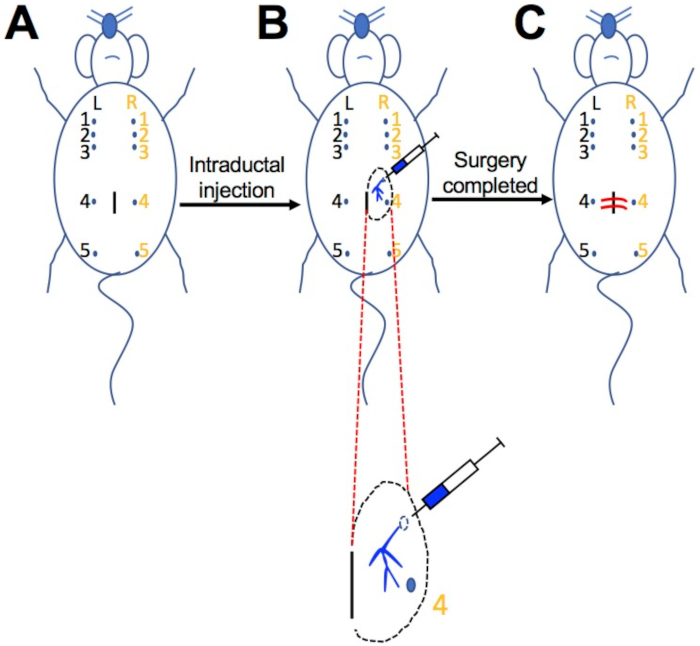É necessária uma assinatura da JoVE para visualizar este conteúdo. Faça login ou comece sua avaliação gratuita.
Intraductal Injection: Delivering Injection Mix into the Ducts of the Mouse Mammary Gland
Overview
This video describes an intraductal injection technique where we deliver injection mix into the ducts of mouse mammary glands.
Protocolo
1. Intraductal injection
- Use aseptic techniques throughout the surgical procedure.
- Make an incision site on the skin at a length of ~1 cm between the two fourth inguinal MGs (Figure 1). Carefully separate the skin flap (with the MG) from the parietal peritoneum so as to visualize the mammary ductal tree.
- Carefully hold the nipple with Watchmaker’s forceps and remove the exterior nipple without cutting any nearby skin, using a micro-dissection scissor.
- Load ~3–5 µL of Ad-Cre injection mixture into a 25 µL Hamilton syringe with a 33 G metal hub needle affixed. Estimate the volume of the injection mixture in the syringe based on the blue dye included in the mixture.
NOTE: Use a smaller volume (e.g., 3 µL) when injecting into MGs of 3–4 weeks old females and a larger volume (e.g., 10 µL) when injecting into MGs of lactating females. - Gently hold the edge of the skin flap with a fine curved tweezer and inject the Ad-Cre injection mixture slowly into the nipple, meanwhile monitoring the spreading of blue dye into the mammary ductal tree. Maintain the injection rate as low as possible to avoid damage to the ductal lumen.
NOTE: Injected fluid (as illustrated by the included bromophenol blue dye) spreading throughout the entire ductal tree without leaking into the stromal compartment indicates a successful intraductal injection. - Gently withdraw the needle from the nipple to avoid any leakage of the injected fluid.
- Examine the distal side (i.e., away from the nipple) of the MG or the surrounding area of the injected nipple. Note that swelling blue dye (i.e., dye diffusing into the nearby stroma) indicates a mammary fat pad injection rather than a successful intraductal injection.
- Close the surgical wounds (from 1.2) in the skin with wound clips.
2. Postoperative care
- Remove the mouse from the anesthesia and place it on a heating pad inside a clean cage for recovery.
- Administer meloxicam subcutaneously at 5 mg/kg again, 24 h after the surgery.
- Monitor the general conditions of the animal and look for signs of infection at the incision site for 5 days.
- Wound clips are removed ~7-10 days after surgery.
Resultados

Figure 1: Schematic diagram of the intraductal injection of Ad-Cre virus into an MG. (A) Incision site in the midline between the two fourth MGs. (B) Intraductal injection of Ad-Cre with a blue dye (for better visualization) into one of the fourth MGs. (C) Closing of the incision in the skin by wound clips
Divulgações
Materiais
| Name | Company | Catalog Number | Comments |
| 33-gauge needle | Hamilton | 7803-05 | point style 3 blunt |
| 7mm Reflex Clip | Braintree Scientific | RF7 CS | |
| Adenovirus, Ad-K5-Cre | University of Iowa Viral Vector Core | Ad5-bk5-Cre (VVC-Berns-1547) | |
| Adenovirus, Ad-K8-Cre | University of Iowa Viral Vector Core | Ad5mK8-nlsCre | |
| Bromophenol Blue | Sigma-Aldrich | B0126-25G | |
| Hamilton syringe | Hamilton | 7636-01 | 0.025 mL |
| Micro-dissecting scissors | Pentair | 9M | Watchmaker's Forceps |
| Micro-dissecting tweezers | Dumont | M5 |
Referências
This article has been published
Video Coming Soon
Source: Xiang, D., et al. Modeling Breast Cancer via an Intraductal Injection of Cre-expressing Adenovirus into the Mouse Mammary Gland. J. Vis. Exp (2019).
Copyright © 2025 MyJoVE Corporation. Todos os direitos reservados